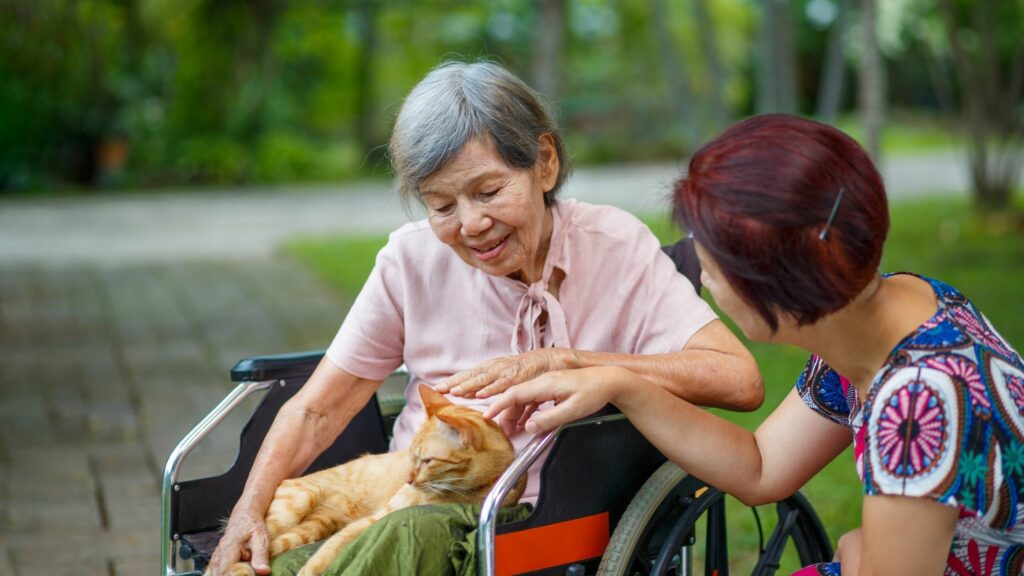Did you know that animals can help us heal? It’s true! Animal-assisted therapy is a growing field, and studies have shown that interacting with animals can have a positive effect on our mental and physical health. In this blog post, we will discuss the benefits of animal-assisted therapy, and we will also introduce you to some of the amazing animals who are helping to change people’s lives for the better.
Contents
- 1 What Is Animal-Assisted Therapy?
- 2 What Are The Goal Of Animal-Assisted Therapy?
- 3 How Animal-Assisted Therapy Work?
- 4 Which Disorders Can Animal-Assisted Therapy Cure?
- 5 How Effective Animal-Assisted Therapy Is?
- 6 Limitation of Animal-Assisted Therapy
- 7 How Animal-Assisted Therapy Is Better Than Other Therapies?
- 8 Conclusion
- 9 A Word From Therapy Mantra
What Is Animal-Assisted Therapy?

Animal-assisted therapy (AAT) is a type of therapy that uses animals to help people cope with physical or mental health conditions. AAT can use to help people manage anxiety, depression, stress, and other mental health issues. It can also use to help people recover from physical injuries or illnesses.
The exact type of animal used in AAT can vary depending on the needs of the person receiving therapy. Common animals used in AAT include dogs, cats, horses, and rabbits. These animals are typically chosen because they are known to be gentle and have a calming effect on people.
AAT is typically provided by a trained therapist or counselor who has experience working with both humans and animals. The therapist will work with the animal and the person receiving therapy to create a treatment plan that meets the individual’s needs.
What Are The Goal Of Animal-Assisted Therapy?

Animal-assisted therapy is a type of therapy that uses animals to help people recover from or manage physical, mental, and emotional conditions. The goals of animal-assisted therapy are as follows:
- Improve a patient’s physical, mental, and emotional well-being
- Help patients develop new skills or cope with challenging situations
- Provide companionship and unconditional love
One of the most important things to remember about animal-assisted therapy is that it is not a cure-all. It is one tool that can use to help people achieve their goals. It is important to work with a qualified therapist who can tailor the therapy to meet your specific needs.
How Animal-Assisted Therapy Work?

AAT works by helping people build relationships with animals. These relationships can provide emotional support and improve self-esteem. AAT can also help people learn new skills, such as how to care for an animal. Animal-assisted therapy can do in individual or group settings. It can do in a hospital, nursing home, rehabilitation center, or mental health facility. AAT may also do in schools and prisons.
AAT is different from other types of therapy because it uses the relationship between people and animals to achieve therapeutic goals. The therapist’s goal is to help the person build a positive relationship with an animal.
AAT is usually provided by a trained therapist or counselor. Some therapists have special training in animal-assisted therapy. The therapist will work with the person to determine what type of animal would be best for them to work with. They will also teach the person how to interact with the animal in a way that is safe and therapeutic.
AAT can use to treat a wide variety of mental and physical health conditions. It can use to help people who have anxiety, depression, stress, PTSD, ADHD, autism, and more. AAT can also help people who are dealing with chronic pain or illness. Animal-assisted therapy is effective in reducing symptoms and improving the quality of life for many people.
Which Disorders Can Animal-Assisted Therapy Cure?

Animal-assisted therapy can help in reducing different disorders such as:
Anxiety
Animal-assisted therapy help in reducing anxiety by providing a sense of comfort and security to patients. The presence of a furry friend can help in calming down anxious patients and help them feel relaxed.
Depression
Patients who are suffering from depression can benefit from animal-assisted therapy as it can help in lifting their mood and making them feel happy. The companionship of an animal can also help in reducing feelings of loneliness and isolation.
Stress
Animal-assisted therapy can also help in reducing stress levels. Spending time with a furry friend can help in releasing the feel-good hormone oxytocin, which can lower stress levels and promote relaxation.
PTSD
Animal-assisted therapy has also been found to be helpful for patients suffering from PTSD. The therapist may use animals to help the patient re-experience positive emotions and start trusting people again.
Decreasing Perceptions Of Pain
Another benefit of animal-assisted therapy is that it can help in reducing pain. Research has shown that interacting with animals can help in releasing endorphins, which are natural painkillers.
It can be a helpful addition to traditional forms of therapy and can help patients recover from different disorders. If you or someone you know is struggling with anxiety, depression, or PTSD, consider animal-assisted therapy as a possible treatment option.
How Effective Animal-Assisted Therapy Is?

- Animal-assisted therapy (AAT) is a type of therapy that involves interactions between humans and animals to achieve therapeutic goals. AAT can use to treat a variety of mental and physical health conditions, and research suggests it may be an effective treatment for some people.
- There are many different ways in which AAT can conduct, but the most common form involves using trained therapy animals to interact with patients in a therapeutic setting. The therapist may use the animal to help facilitate sessions, or the animal may simply provide companionship and emotional support.
- AAT is beneficial for treating conditions like anxiety, depression, PTSD, stress, loneliness, and more. It can also help improve social skills, communication skills, and overall well-being.
- If you’re considering AAT for yourself or a loved one, it’s important to find a qualified therapist who has experience working with therapy animals. You’ll also want to make sure the animal is comfortable around people and has been properly trained for the role. If you have any concerns about AAT, be sure to discuss them with your therapist before beginning treatment.
- Animal-assisted therapy is a promising treatment option for many people struggling with mental and physical health conditions. If you think AAT might be right for you, be sure to do your research and find a qualified therapist to help you get started. With the support of a furry friend, you could start on the path to healing today.
Limitation of Animal-Assisted Therapy
Animal-assisted therapy is not suggested as a standalone treatment for mental disorders or as a replacement for traditional therapies. It is meant to be used in addition to other forms of treatment, such as cognitive-behavioral therapy, and not as a substitution for any necessary medical care.
Animal-assisted therapy is not for those who have:
Safety Concerns
Some safety concerns need to consider when using animals in therapy, such as the potential for bites or scratches from an animal. The therapist should always have liability insurance in case of an accident.
Comfortability Issues
Another thing to consider is the comfort level of both the patient and the animal. If a patient does not feel comfortable around animals, then animal-assisted therapy may not be right for them. The same goes for the animal; if an animal does not like being around people, then it will not be able to provide therapeutic benefits.
Allergic Reactions
Some people may also have allergic reactions to certain animals, such as dogs or cats. In these cases, it is important to find an animal that does not trigger an allergic reaction in the patient.
It can be a great way to supplement other forms of treatment for mental disorders. However, some things need to be considered before starting this type of therapy. By taking into account the safety concerns, the comfort level of both the patient and animal, and any allergies the patient may have, animal-assisted therapy can be a safe and beneficial experience for all involved.
How Animal-Assisted Therapy Is Better Than Other Therapies?

This is more effective than other therapies for several reasons:
- Animals provide us with companionship and unconditional love which can help reduce stress and anxiety levels.
- Interacting with animals helps to increase our sense of responsibility and self-esteem.
- Animal-assisted therapy can help us to develop new skills and learn how to cope with difficult situations.
If you are considering seeking out therapy, animal-assisted therapy is an excellent option! Not only will you benefit from the companionship of a furry friend, but you will also find that the therapy is more effective than other types of therapy. So why not give it a try? You may be surprised at how much better you feel!
Conclusion
In conclusion, animal-assisted therapy is a promising and beneficial form of treatment that should be considered for those struggling with mental health issues. The benefits of animal companionship are vast, and the positive effects of therapy dogs on mental health are well-documented. If you or someone you know is struggling, consider seeking out a therapist who offers animal-assisted therapy sessions.
A Word From Therapy Mantra
Your mental health — Your psychological, emotional, and social well-being — has an impact on every aspect of your life. Positive mental health essentially allows you to effectively deal with life’s everyday challenges.
At TherapyMantra, we have a team of therapists who provide affordable online therapy to assist you with issues such as depression, anxiety, stress, workplace Issues, addiction, relationship, OCD, LGBTQ, and PTSD. You can book a free therapy or download our free Android or iOS app.


